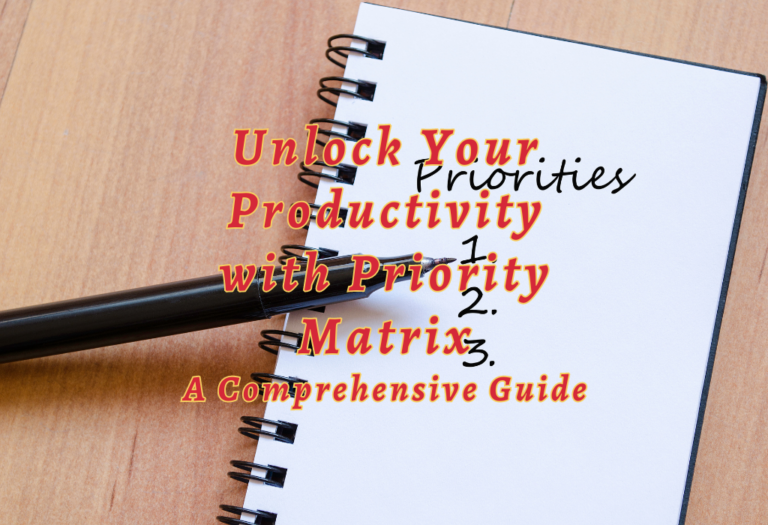How To Be More Productive? Tips & Secrets To Achieve The Maximum!
If you want to get more done, increase productivity, and make the best use of your time, you need a few strategies to help set you up for success. But the time-saving tools and planning tricks available can be overwhelming.
In this post, we boil it down to the top 10 proven strategies you can implement to make your life simpler and reach your goals faster. From creating a daily routine to freeing yourself from distractions, these tips will get you on the path to improved productivity and, ultimately, achieving your goals. Ready to get more done? Let’s get started!

Quick Clarification
Establishing a routine that works for you is vital to increasing your productivity. It could include regular breaks, setting realistic goals and objectives, and minimizing distractions.
What are the characteristics of highly productive people?
Following are the some key characteristics of productive people:
Create a Productivity Strategy
Creating a productivity strategy is one of the most critical steps in becoming more productive.
What are the benefits of developing a productive strategy?
By developing a strategy, you can get the following benefits:
How to create a productive strategy?
Nevertheless, creating a productive strategy can be challenging – especially if this is your first time.
Goals will ultimately drive us towards achieving our desired objectives; setting achievable goals is essential for success and remaining motivated throughout the process.
Setting Achievable Goals to be productive
Setting achievable goals is an integral part of productivity. It enables individuals to accomplish their objectives in a specific period instead of letting the tasks accumulate and become overwhelming. Plans are also helpful for breaking large projects into smaller chunks, so they get managed more efficiently.
How to set achievable goals?
Consider the following points to set an achievable goal:
In conclusion, setting achievable goals is critical for increasing productivity, providing motivation, and helping individuals stay focused on their tasks. As with goal setting, a balance must be maintained so that expectations remain reasonable and attainable. Now that we’ve discussed the importance of goal setting let’s explore how to create a plan to achieve those goals.
How to Create a Plan?
Creating a plan is essential to success in any endeavor, particularly regarding increased productivity. A well-crafted plan provides structure and guidance when tackling big projects and helps to ensure efficient use of time and resources.
Additionally, when an individual creates a plan for success, it allows them to break down larger goals into achievable tasks. With clearly defined steps before taking action, each new job will be easier to complete in a shorter time.
Following are some tips to create a plan:
Now that we have discussed creating a plan for increasing productivity and achieving our goals, let’s dive into how to put it into motion with our next section on taking action & focusing on what matters.
Take Action & Focus on What Matters
When it comes to increasing productivity and accomplishing more, “taking action” is one of the key strategies to focus on. Having a vision is great, but taking the steps necessary to bring that vision to life is even better. Taking action pushes your progress forward and aids in creating momentum – if you want to make things happen and become more productive, then taking action is a must.
The critical takeaway is to take the appropriate actions and be diligent about focusing time and energy on tasks that truly matter. It will not only increase productivity but build up consistency over time as well.
Now that we’ve discussed the importance of taking action and focusing on what matters let’s look at another strategy for increasing productivity: prioritizing tasks.
How to Prioritize Tasks to be productive?
Prioritizing tasks can be one of the most effective strategies for increasing productivity and getting more done. Many people feel overwhelmed when presented with numerous studies, so prioritizing them can help focus their efforts on the most critical and time-sensitive items first.
For example, if a student has a paper due in two days and a test to prepare for next week, they should prioritize the paper ahead of studying. It will help ensure that all deadlines are met.
Follow these tips to set a priority for your tasks:
The following section discusses how setting up a productive environment can further assist with getting tasks accomplished faster and more effectively.
How to Create a Productive Environment
Creating a productive environment is an essential step in increasing productivity. Research indicates that a conducive working atmosphere can positively affect motivation and consequent performance. A work environment should offer staff and employees comfort, relaxation, inspiration, and positive reinforcement to encourage productivity.
1. Understanding the needs of individuals
It is essential to comprehend the needs of the individuals involved. Consider factors such as space, lighting, temperature, noise levels, and organizational systems tailored to meet those needs. In doing so, staff will be better equipped to stay focused on the task while readily having what they need available.
2. Implement Order and Improve Focus
In addition, implementing order and routine within your environment can reduce stress caused by clutter or disorganization. Stillness is vital; remove any distractions from view like televisions or allow for flexible seating such as standing desks or floor mats to accommodate individual preferences. Renewed Focus will enhance productivity for extended periods, making working less tiresome and more satisfying.
3. Setting a Creative Environment
On the other hand, an overly sterile environment can also foster negative results in an office setting. Cold tones and minimal decorations can create a corporate feeling that can be intimidating for many people or lead to feelings of detachment from colleagues or the task at hand. Decoration gets kept at a minimum with tasteful elements like plants or artwork on walls which help create warmth within the atmosphere; painting walls a suitable color may also be physically and psychologically beneficial by adding life and revitalizing one’s mood.
It is essential to understand how habits contribute towards productivity and take necessary steps to change them. Next, we will delve into how modifications in daily routine can positively impact improved productivity.
How can Change in Your Habits Increase Productivity?
When it comes to increasing productivity, the power of habit gets considered. Patterns can significantly impact how much you get done and how successful you are in reaching your goals. Gaining control over your bad habits and forming good habits is one of the most effective strategies for becoming more productive.
1. Understanding the reason for an act
The key to changing habits is understanding why we act a certain way in the first place. Behavior is driven by three primary motivations: pain and pleasure, practice, and the avoidance of habit change. Identifying these motivations can help us find better ways to motivate ourselves.
2. Changing you lifestyle
Making small but consistent changes to our daily routines or lifestyle can effectively improve our overall productivity. For instance, if you’re notoriously disorganized, focus on developing a system that works for you, such as keeping a simple list of tasks or maintaining a color-coded calendar of deadlines. Similarly, try setting aside a specific time each day when you focus entirely on completing a mundane but essential task. These little changes will eventually become second nature and contribute to greater efficiency in the long term.
3. Avoid extra perfectionism
On the other hand, it’s essential to avoid the trap of perfectionism here; be kind to yourself and don’t expect dramatic change overnight. Change takes time and dedication, so keep going despite slow progress. Adjusting your attitude and expectations as needed will go a long way towards getting—and staying—on track with your productivity goals.
Forming good habits is about maintaining consistency until they become part of who we are. As Oscar Wilde once said: “Success is a matter of habit,” — so proactively shape yours today to plan for success tomorrow!
What are some ways to break large tasks into smaller ones?
Breaking large tasks into smaller ones is a great way to increase productivity and help get things done. Here are some effective strategies:
1. Prioritize tasks
Make a list of the tasks that need to be completed in order of priority. It will help you focus on the most critical tasks first, allowing you to break them into small, manageable pieces rather than trying to tackle them all at once.
2. Set deadlines
Setting deadlines for yourself helps create structure and motivates finishing each task. The deadlines should also be realistic and achievable so that you can work towards completing them without getting overwhelmed or discouraged.
3. Break each task down into smaller tasks
Once you have identified the more significant tasks, break each down into smaller tasks that get accomplished within reasonable timeframes. By breaking it down into smaller pieces, you’ll be able to focus on one task at a time and feel more accomplished when each part is completed.
4. Utilize lists
Creating lists of your various tasks can help you stay organized while working through an individual project. These lists can also serve as a reference point if ever needed.
5. Reward yourself
Finally, it’s important to reward yourself after completing each step or milestone along the way. Even if it’s something small like indulging in your favorite snack or taking a few minutes to relax, celebrating small victories will provide extra motivation and help keep you on track with completing the project.
Conclusion
Increasing productivity and getting more done involves a lot of effort, and no tried-and-true methods will work for everyone. That being said, the strategies listed above are some of the most successful ways to incorporate them into your daily routine to improve your workflow and get more done. The key is tailoring the approaches to best suit your lifestyle, productivity style, and goals.
On the other hand, it’s also important to avoid procrastinating entirely, as it can reduce your Focus and motivation while severely hindering your overall performance. Therefore, striking a balance between continuing progress despite struggles and realizing when it’s time for a break can improve productivity levels and overall mental well-being.
By following the strategies listed above, you can manage your workflow better to reach your goals and increase productivity. With practice and dedication, you should see improvements toward reaching the levels of performance required for success in any given endeavor.






